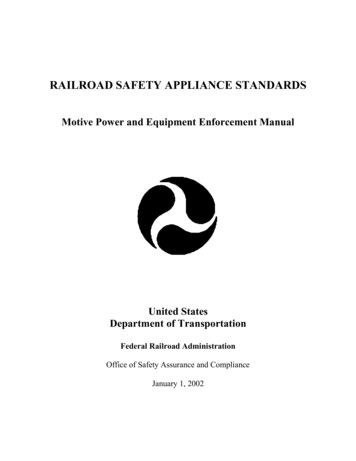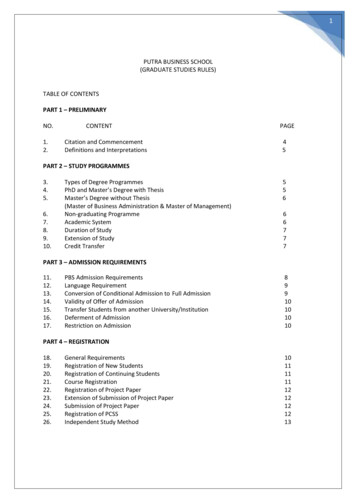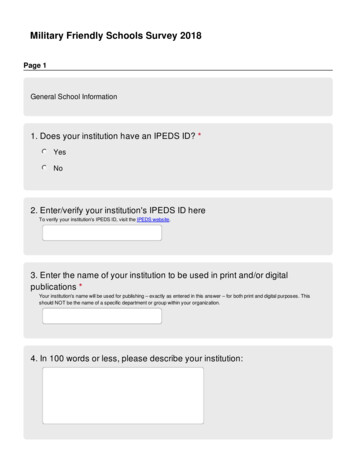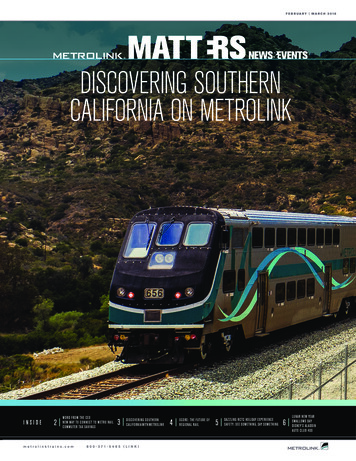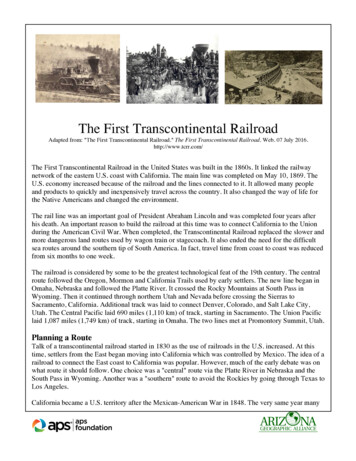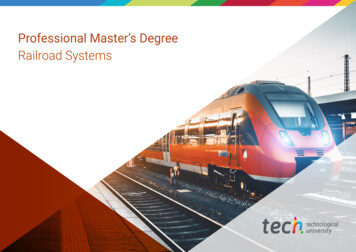
Transcription
Professional Master’s DegreeRailroad Systems
Professional Master’s DegreeRailroad SystemsCourse Modality: OnlineDuration: 12 months.Certificate: TECH Technological UniversityOfficial Nº of hours: 1,500 h.Website: -degree/master-railroad-systems
Index0102IntroductionObjectivesp. 403Skillsp. 80405Course ManagementStructure and Contentp. 14p. 18p. 240607MethodologyCertificatep. 34p. 42
01IntroductionThe Railroad System has undergone many changes in recent years, a notable advancebeing the commitment of the state governments of a large number of countries toextend and modernize the system. Due to the new high-speed passenger services, thedecongestion of cities through new urban rail systems and the necessary transfer ofgoods from other modes of transport to rail, a permanent evolution of this system isbeing contemplated. In addition, it is the most environmentally sustainable mode oftransport, which is a highly important feature at this time. This makes it essential tohave specialized professionals in this area. That's why the program in Railroad Systemsis designed so that the student is able to start specializing in the new technologies thathave an impact on this growing field.
Introduction 05It analyzes the new requirements and advancesof the Railroad System from a dynamicperspective and is backed by the extensiveexperience of excellent teaching staff"
06 IntroductionThe railroad was not born from a spontaneous idea, but after a long process to improvethe transportation of coal that began in the 17th century. In those days, the trackswere built with wooden beams that were supported and nailed to sleepers. Over time,this system has evolved and received greater support from state governments. Thishas favored its path to becoming an environmentally sustainable means of transport,something very much in demand in today's industry. Thus, it has become a fundamentalrequirement for engineers in this area to continue their academic studies and specializein a field with a great international projection.This Professional Master's Degree explores the engineering and operation of railroadsfrom a traditional, technical and operational perspective, but taking into accountthe current international context, which establishes new specific requirementsfor professionals in this sector. Special emphasis is placed on the new trendsand technologies towards which the railroad is moving, in order to increase itstechnical efficiency and its service to society. Likewise, an analysis of the new safetyrequirements that are substantially conditioning the design and operations of theRailroad Systems is proposed.The program is applicable in all geographical areas related to railroads, with a clearinternational dimension. We have taken into account specific aspects of railroadnetworks, projects and services that represent an outstanding reference in the railroadfield and therefore are of great interest for the student. The Professional Master'sDegree has been planned in a practical way, so that the contents can be directly appliedin the different professional fields of the railroad.New technologies play an important role in this program. The railroad sector requiresprofessionals who, already having technical competence in the traditional aspects ofthe sector, are familiar with, and know, the new challenges that the railroad is facing. Forthis reason, this program incorporates specific modules on research, development andinnovation in the sector and on the digital transformation it is undergoing, all of whichare key elements in the new strategy to be followed.This Professional Master's Degree in Railroad Systems contains the most completeand up-to-date educational program on the market. The most important features of theprogram include: Improve professional skills in the field of railroad systems Update and focus the student's company's strategies in these terms Demand new requirements in the technology acquisition processes Add value to the technical projects to be developed by student's companies andorganizations The graphic, schematic, and eminently practical contents with which they are created,provide scientific and practical information on the disciplines that are essential forprofessional practice Practical exercises where the self-assessment process can be carried out to improvelearning Special emphasis on innovative methodologies Theoretical lessons, questions to the expert, debate forums on controversial topics, andindividual reflection assignments Content that is accessible from any fixed or portable device with an Internet connectionWith the graphic and practical content,this Professional Master's Degree providesstudents all the knowledge they need intheir daily work day"
Introduction 07Have access to a program that isapplicable in all geographical areasrelated to railroads, and has a clearinternational dimension”Become a professional in the railroad sector bypossessing the technical competencies in thetraditional aspects of the sector.Apply the new concepts of safe design andmodifications in the Railroad System inservice to your professional field.The program’s teaching staff includes professionals from sector who contribute theirwork experience to this training program, as well as renowned specialists from leadingsocieties and prestigious universities.The multimedia content, developed with the latest educational technology, will providethe professional with situated and contextual learning, i.e., a simulated environment thatwill provide immersive training programmed to train in real situations.This program is designed around Problem Based Learning, whereby the professionalmust try to solve the different professional practice situations that arise during theacademic year. For this purpose, the professional will be assisted by an innovativeinteractive video system created by renowned and experienced experts.
02ObjectivesIn order to acquire the competencies that the student needs to gain up-to-dateknowledge in this sector, a program has been designed to deepen understanding of thekey aspects of Railroad Systems. The knowledge gained in throughout the course willhelp the professional from a global point of view, with comprehensive training to helpthem achieve the proposed objectives. You will develop your skills in pursuit of reachingan eminently technological objective, gaining up-to-date knowledge of current trends inrailroad systems.
Objectives 09Implement new strategies to manage the needsof the technological modernization of theRailroad System, fulfilling a series of objectivesthat will boost your professional career"
10 ObjectivesGeneral Objectives Gain in-depth knowledge of the different technical concepts of the railroad in its differentfields Know the technological advances that the railroad sector is experiencing mainly due tothe new digital revolution, but without forgetting the traditional approaches on which thismode of transport is based Understand the changes in the industry that have triggered the demand for new technicalrequirements Implement strategies based on the technological changes that have arisen in the sector Gain up-to-date knowledge in all aspects and trends of railroads
Objectives 11Specific ObjectivesModule 1. The Railroad and Its Engineering in the Current Context Analyze the position of the railroad with respect to other modes of transportation,identifying its main advantages and areas for improvement Gain in-depth knowledge of the current structures and organizations on which the railroadsector is based (regulators, railroad managers, industry, institutions, groups, etc.) Analyze the different regulations and norms on which the railroad sector is currentlybased Discuss in detail the main technological trends that the sector is currently experiencing Gain in-depth knowledge of the characteristics of the different railroad operating systems,the main technical areas in the infrastructure and rolling stock Establish the technical interactions between infrastructure and rolling stock, as well asthe existing technical criteria and conditions for the design of Railroad Systems Explain different worldwide references in terms of railroad networks, infrastructures andtechnical projects with high impact on the sectorModule 2. Electric Traction Energy Make an exhaustive analysis of the main technical aspects of electric traction energy inrailroads, highlighting the most important milestones and their current situation Specify the technical characteristics of the installations associated with the electrictraction energy according to the different Railroad Systems Gain a deeper understanding of the specific aspects related to the electric brakingsystems used on trains and their strategic importance for the railroad infrastructure Establish the technical characteristics of the different components that make up therailroad electrical system, including a detailed analysis of it Address the particularities of electrification in direct current and single-phase alternatingcurrent, emphasizing their operational advantages and disadvantages Analyze the characteristics that the engineering project associated with the tractionelectric power installations must have Direct the student in the practical application of the content presentedModule 3. Control, Command and Signaling (CCS) Explain in a clear and structured way the main technical aspects of the installationsassociated with railroad control, command and signaling Specify the technical characteristics of the different components that make up the CCSsystem Provide an in-depth breakdown of the specific characteristics of ERTMS and CBTCsignaling systems, as the newest standardized systems in the current context Specify in detail the technical characteristics of the CCS installations according to thedifferent Railroad Systems
12 Objectives Analyze the characteristics that the engineering project associated with CCS installationsmust have Establish the characteristics of the track devices, highlighting the turnouts, switches andcrossings, as well as other auxiliary elements associated with the operation of the track Direct the student in the practical application of the content presented Address the technical characteristics of the civil infrastructure according to the differentRailroad SystemsModule 4. Telecommunications Identify the main technical aspects of the railroad telecommunications in the currentmoment Integrate the concept of infrastructure resilience to external events, analyzing its currentimportance in the strategy of railroad infrastructure management companies Specify the technical characteristics of the different components that make up fixedrailroad telecommunications Direct the student in the practical application of the content presented Gain in-depth knowledge of the technical characteristics of the different components thatmake up the rail mobile telecommunications, including future migration to the FRMCSstandard Reflect on how telecommunications on the railroad is currently focused on a commercialbusiness where third parties use the railroad's own infrastructure Analyze the characteristics that the engineering project associated withtelecommunication installations must have Direct the student in the practical application of the content presentedModule 5. Civil Infrastructure Gain deeper understanding of the interaction of the vehicle with the civil infrastructure,analyzing in detail the dynamic phenomena that occur, in order to determine the designparameters of the platform and the rest of the components Specify the technical characteristics of the different components that make up theinfrastructure subsystem, such as platform, tunnels, bridges and viaducts Specify the characteristics of the road as the main component of the civil infrastructureTaking into account its traditional typology as a ballastless track, analyzing the differentelements involvedModule 6. Rolling Stock Perform an in-depth study of the main technical aspects of rail vehicles Explain in a clear and structured way the technical characteristics of the differentcomponents that make up the railroad rolling stock Specify the technical characteristics of railroad dynamics from a rolling stock point ofview Analyze the aspects governing the maintenance of railroad vehicles Direct the student in the practical application of the content presentedModule 7. Risks and Safety Make the student reflect on the importance that this aspect has nowadays in railroadengineering and operation Master the various regulations governing the application of this type of process on thedifferent railroad systems and subsystems undergoing a change that may have safetyimplications Specify the different agents involved in the risk and safety management process Gain in-depth knowledge in the different steps to be followed to apply the process on thedesign of a system or in the case of a modification when it is already in service
Objectives 13 Apply the concepts learned in a practical way in real casesModule 8. Operation Establish the main technical aspects of rail operation activities at the present time Specify the main factors affecting rail traffic regulation, including the correspondingcapacity analyses Analyze the particularities of passenger and freight rail transport Address the economic criteria currently governing the management of railroadcompanies, both in terms of infrastructure management companies and railroadtransport companies Make the student reflect on the importance of energy consumption in the railroad sectorand how energy efficiency measures need to be incorporated into the business strategy,while analyzing each of these measures Specify how the different operational incidents in the service should be managed throughplans, resources and decision centers Analyze the scope of safety and civil protection in the railroad sector, specifying thedifferent plans, resources and decision centers Specify, for each technical area analyzed, the particularities in terms of research,development and innovation, highlighting the main lines of work, associated initiativesand existing working groups Address the most disruptive Railroad Systems, i.e., those that do not use traditionaltechniques for their operation, such as magnetic levitation systems and those based onthe new Hyperloop conceptModule 10. The Digital Revolution in Railroads Reflect on the technological evolution of the railroad, including the new digital revolution itis currently undergoing Analyze the different digital technologies applicable to the railroad sector, specificallydetailing the most strategic ones Master the application of new digital technologies in different areas of the railroad,identifying the associated improvements: traction energy, passenger stations, railroadlogistics, maintenance and traffic management Reflect on the importance of cybersecurity in the railroad sector Analyze digitization programs and strategies in different world railroadsModule 9. Research, Development and Innovation (R&D&I) Make the student reflect on the importance of developing a business strategy basedon research, development and innovation in railroad technology, identifying the newtechnological challenges posed Analyze the current situation with respect to research, development and innovationprograms, as well as the different policies and strategies to promote and finance them We will place special emphasis on the different phases and stages of the research,development and innovation process, including the management of the final resultsobtainedWith a methodology based on practicalcases, it meets the objectives that willhelp you grow in a highly demandedsector at a global level"
03SkillsThis Professional Master's Degree complies with the designed structure so that theprofessional is able to identify and solve problems related to the Railroad System,following a unique methodology and with the support of the experts who havedeveloped the content of the course. TECH guarantees students quality content thatmeets their expectations, giving them the opportunity to excel in their field. Additionally,the student will be able to perform the various functions related to this ProfessionalMaster's Degree, along with the most innovative proposals in this field of action,thus guiding them towards excellence. A series of topics demanded by industryprofessionals and today's world.
Skills 15With a specific criterion of practicaltraining, this program will allow you toconvert your learning into real professionalskills, almost immediately"
16 SkillsGeneral Skills Master the different technical concepts that have been addressed in the railroad field Apply the knowledge acquired in technological advances and improve their problemsolving skills in current and global environments within broader industry contexts Know how to integrate knowledge and gain an in-depth view of the differenttraditional and modern approaches to management in a railroad system Understand the changes in the industry that have triggered the demand for newtechnical requirements Be capable of implementing new strategies based on the technological advances ofthe sectorBoost your professional careerby fulfilling the competencies ofa Professional Master's Degreedesigned by excellent experts inthe Railroad System"
Objectives 17Specific Skills Be able to analyze the position of the railroad with respect to the rest of the modes oftransport, deepening understanding of the current structures and transport organizationsthat are involved in the sector Analyze the interaction of the vehicle with the civil infrastructure, taking into accountthe dynamic phenomena that occur, in order to determine the design parameters of theplatform and the rest of the components Identify the different regulations and current guidelines on which the railroad sector iscurrently based Analyze in a clear and structured way the technical characteristics of the differentcomponents that make up the railroad rolling stock Develop an exhaustive analysis of the main technical aspects of electric power andspecify the technical characteristics of traction electrical installations Master knowledge of the various regulations governing the application of railroadsprocesses on the different systems and subsystems undergoing a change in order toguarantee safety Gain knowledge on the particularities of direct and alternating current electrification,emphasizing their operational advantages and disadvantages Develop the necessary communication skills to explain in a clear and structured way themain technical aspects of the installations associated with railroad control, commandand signaling Analyze in detail the characteristics that the engineering project associated with the CCSinstallations must have Master the identification of the main technical aspects of railroad communications intoday's world Be able to delve into the technical characteristics of the various components that makeup rail mobile components of railroad mobile telecommunications, including futuremigration to the FRMCS standard Reflect on how telecommunications in railroads is currently focused on a commercialbusiness in which third parties use the railroad's own infrastructure Analyze the economic criteria currently governing the management of railroadcompanies, both in terms of infrastructure management companies and railroadtransport companies Understand the importance of energy consumption in the railroad sector and how thevarious measures adopted are necessary to improve the business strategy Analyze the current situation with respect to research, development and innovationprograms, as well as the different policies and strategies to promote and finance them Know and specify the different phases and stages of the research, development andinnovation process, including the management of the final results obtained Reflect on the technological evolution of the railroad, including the new digital revolution itis currently undergoing Master the application of new digital technologies in different areas of railroad systems,identifying the associated improvements
04Course ManagementIn accordance with its maxim of offering an elite education for all, TECHcounts on renowned professionals in order for the student to acquiresolid knowledge in the specialty of Railroad Systems. For this reason, thisProfessional Master's Degree has a highly qualified team with extensiveexperience in the sector, which will offer the best possible resources forstudents in the development of their skills during the course. In this way,students have the guarantees they need to specialise at an international levelin a booming sector that will catapult them to professional success.
Course Management 19Continue your professional career with thesupport of experts in the field of railroadsystems at a national and international level"
20 Course ManagementMr. Martínez Acevedo, José Conrado Experience in the public railroad sector, occupying various positions in construction, operation and technological development of theSpanish high-speed and conventional railroad networks Head of Research, Development and Innovation projects at Administrador de Infraestructuras Ferroviarias (Adif), a state-ownedcompany attached to the Spanish Ministry of Transport, Mobility and Urban Agenda (MITMA) Coordinator of more than 90 technology projects and initiatives in all areas of the railroad Industrial Engineer and Master's Degree in Specialization in Railroad Technologies and in Construction and Maintenance of RailroadInfrastructures Professor in the Master's Degree courses on railroads at the Pontificia de Comillas University (ICAI) and the University of Cantabria Member of the IEEE (Institute of Electrical and Electronics Engineers) and member of the Editorial Committee of ElectrificationMagazine at the same institution (magazine specialized in transportation electrification) Member of the AENOR group CTN 166 "Research, Technological Development and Innovation Activities (R&D&I)" Adif representative in the MITMA R&D&I and EGNSS (Galileo) working groups Speaker at more than 40 congresses and seminars
Course Management 21ProfessorsDr. Martínez Lledó, MarianoMr. Fernández Sánchez, Angel Experience in the public railroad sector, occupying various positions in construction,operation and technological development of the Spanish high-speed and conventionalrailroad networks Control, Command and Signaling Technician at Administrador de InfraestructurasFerroviarias (Adif), a state-owned company attached to the Spanish Ministry of Transport,Mobility and Urban Agenda (MITMA) Head of Research, Development and Innovation projects at Administrador deInfraestructuras Ferroviarias (Adif), a state-owned company attached to the SpanishMinistry of Transport, Mobility and Urban Agenda (MITMA) Director of Control, Command and Signaling Projects, including: suppression oftelephone blockades, installation of automatic banalized blockades, standardizationand modernization of blockades and modernization of interlocks and interlockings, and PhD in Spanish Philology, specialized in applied linguistics (Doctoral thesis:The specialized language of railroads) and a Master's Degree Degree in InternationalStrategic Management. Several specialization courses in technological surveillance andcompetitive intelligence Internal trainer in the area of railroad R&D&i (Integral Training Program for Technicians) International trainer in the area of operation, traffic control and railroad innovation(Morocco, Mexico, France) Professor in the Master's Degree in International Strategic Management offered by Adif,Indra and the Polytechnic University of Madrid Speaker at several congresses and seminars with papers on terminology and linguisticsapplied to railroadseffects on the CCS subsystem derived from infrastructure projects Responsible for the analysis and study of blocking systems based on alternativetechnologies in Adif's Conventional Network. Case study, Cáceres-Valencia de Alcántara Industrial Engineer and Master's Degree in Engineering and Land TransportationManagementMr. García Ruiz, Mariano Head of Telecommunications in the General Directorate of Conservation and Maintenanceat Administrador de Infraestructuras Ferroviarias (Adif), a state-owned company attachedto the Spanish Ministry of Transport, Mobility and Urban Agenda (MITMA) Experience in the railroad sector, having held various positions of responsibility in severalprojects and construction works of the Spanish high-speed rail network: GSM-R MobileTelecommunications on the Madrid-Lleida, Córdoba-Málaga and Madrid-ValenciaAlbacete-Alicante High Speed Lines; GSM-R Fixed and Mobile Telecommunications on theMadrid-Toledo and Madrid-Segovia-Valladolid High Speed Lines Responsible for Maintenance and Operation of the Fixed Telecommunications, GSM-RMobile, Energy Remote Control and Public Mobile Telephone Operator facilities of theSpanish high-speed network Telecommunications Engineer and Master's Degree in Construction and Maintenance inRailroad Infrastructures
22 Course ManagementMr. Morales Arquero, Ramón Currently Process Manager of the Entity in Charge of Maintenance in the Technical andOperations Management of the High Speed Business Area of RENFE Viajeros Experience in projects of substations and overhead HV and MV power lines at UniónFenosa Engineering Experience in the public railroad sector, occupying various positions in rolling stockengineering activities in the area of acquisition and commissioning of new trains,innovation and modification of existing trains in the Directorate of Commuter and MediumDistance Trains. Also has experience in the area of maintenance and management of highspeed and long distance rolling stock in the Directorate of High Speed and Long DistanceOperations of RENFE Industrial Engineer and MBA in Business Administration. Teaching period of thePhD program in Electrical Engineering at the Polytechnic University of Madrid and aPostgraduate Diploma in Railroad Technology at the UNED (National Distance EducationUniversity) Speaker at more than 15 congresses and seminarsMr. de Bustos Ferrero, David Experience in the private railroad sector His professional career has been spent withleading rail manufacturers and technologists, as well as safety assessment andcertification companies Focused on the execution and management of critical safety projects, mainly rolling stockand signaling systems, during his last phase he has focused on the development of newpropulsion technologies such as LNG and H2 (Liquefied Natural Gas and Hydrogen) Industrial Engineer and a Master’s MBA General Management Training Program GMTP
Course Management 23Complete, up-to-date and highlyefficient training. This ProfessionalMaster’s Degree is the opportunityto take a leap in your professionalskills and compete among thebest in the sector"
05Structure and ContentThe syllabus has been designed according to the requirements of the Railroad System,complying with the requirements proposed by the teaching team of the ProfessionalMaster's Degree. Thus, a syllabus has been established whose modules offer a broadperspective of the railroad and its engineering in the current context, dealing with themain technological proposals of the sector in detail. All this, from a global perspectivefor the sake of its application at an international level, incorporating all the fields of workinvolved in professional development in this type of work environment. From module1, students will see their knowledge expanding, which will enable them to developprofessionally, knowing that they can count on the support of a team of experts.
Structure and Content 25Fulfill a curriculum that willpropel your career to aninternational level in a fieldthat is growing every day"
26 Structure and ContentModule 1. The Railroad and Its Engineering in the Current Context1.1.1.2.1.3.1.4.1.5.1.6.1.7.The Railroad in Transport1.1.1.Its Position and Competency With Other Modes of Transport1.1.2.Sectorial Analysis1.1.3.Financing1.1.4.Specialty Railroad Language and TerminologyOrganization1.2.1.Regulatory Organizations and Supervisors1.2.2.Industry1.2.3.Administrators of Infrastructure1.2.4.Railroad Transport Companies1.2.5.Institutions and Associations1.8.1.9.Regulation, Legislation and Guidelines1.3.1.Legal Framework and Regulation1.3.2.The Liberalization of Rail Transport1.3.3.Technical RegulationsInteroperability of Different Technological Systems1.4.2.Towards Digitalization: Railroad 4.01.4.3.A New Service Model for SocietyDescription of Railroad Services1.5.1.Urban Services1.5.2.Mid- and Long-Distance Services1.5.3.High-Speed Services1.5.4.Freight ServicesClassification and Main Infrastructure Systems1.6.1.Electric Traction Energy1.6.2.Control, Command and Signaling1.6.3.Telecommunications1.6.4.Civil Infrastructure1.7.1.Main Types1.7.2.Traction1.7.3.Braking1.7.4.Control, Command and Signaling1.7.5.RollingInteraction Between Vehicle and Infrastructure1.8.1.Different Interactions1.8.2.Technical Compatibility of the Vehicle With the Infrastructure1.8.3.The Problem of the Width of the Track and Its Main SolutionsCriteris and Technical Conditions of the Railroad1.9.1.Maximum Speed1.9.2.Typology of the Rolling Stock1.9.3.The Capacity of the Transport1.9.4.Interrelation Between the Different Subsystems1.10. Cases of Global References1.10.1. Rail Networks and ServicesNew Trends and Strategies1.4.1.Classification and Main Rolling Stock Systems1.10.2. Infrastructures in Construction and in Service1.10.3. Technological ProjectsModule 2. Electric Traction En
are key elements in the new strategy to be followed. With the graphic and practical content, this Professional Master's Degree provides students all the knowledge they need in their daily work day" This Professional Master's Degree in Railroad Systems contains the most complete and up-to-date educational program on the market.
